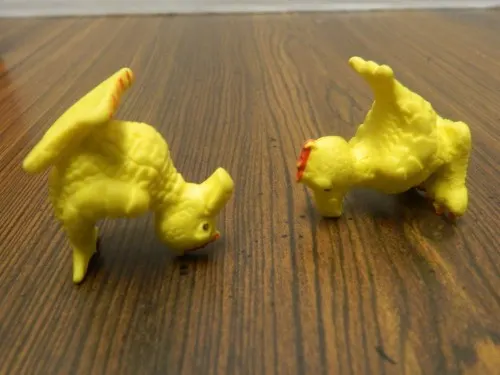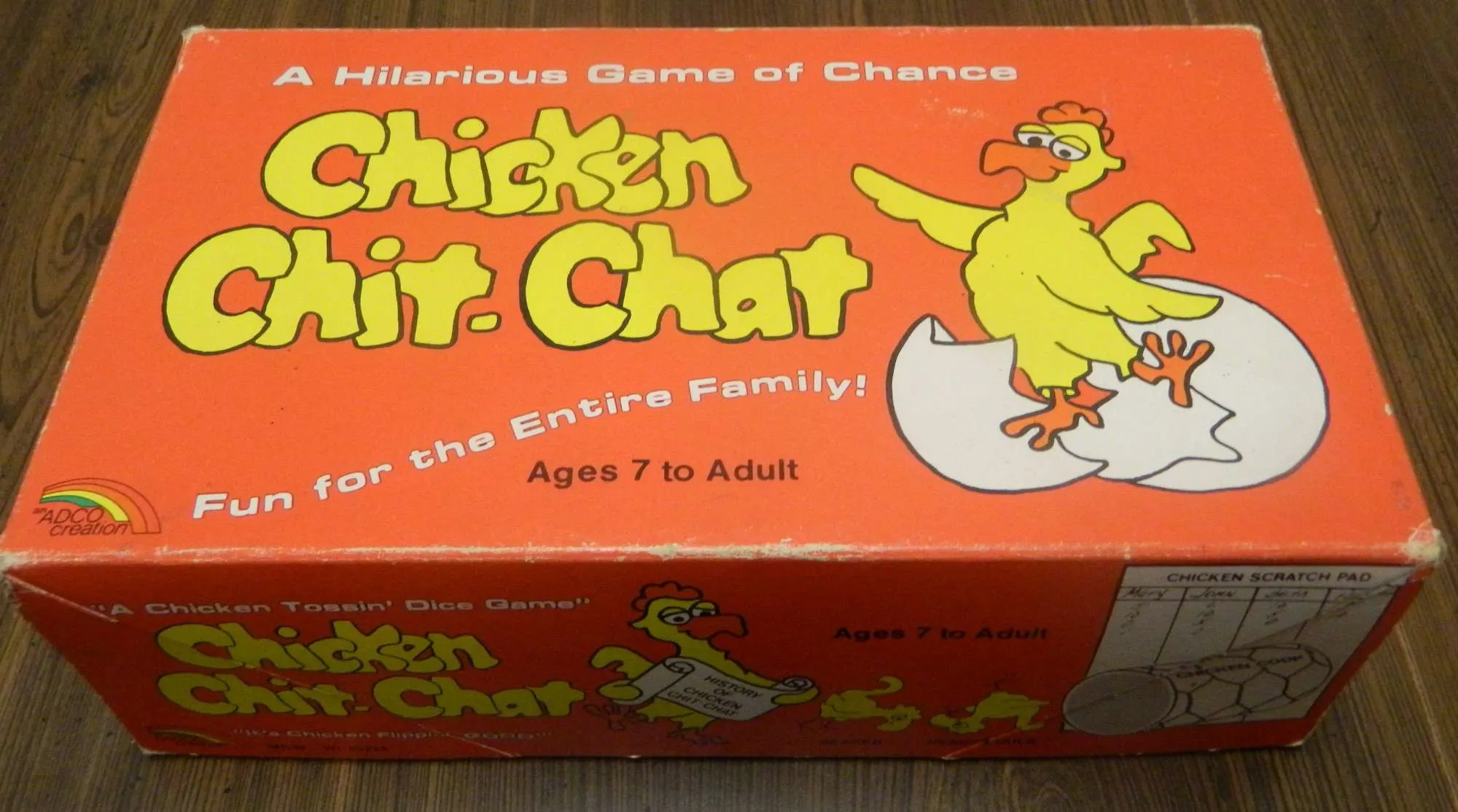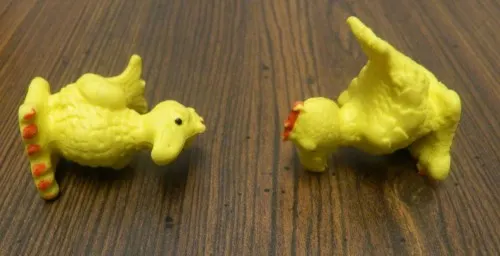How to Play
To begin the game all of the players roll the dice once to determine who goes first. Whoever rolls the highest valued combination gets to roll first. On a player’s turn they roll the dice and determine how many points they scored (see the chart below). These points are added to their current running total. If the player rolled for more than ten points, they roll the dice again. Each time the player rolls for more than ten points they get to roll the dice again. Whenever a player rolls for less than ten points, their turn ends and play moves to the player on the left. The first player to reach 200 points wins the game.
Below is the point chart for Chicken Chit-Chat
- Chicken Chit: Both chicken dice are balanced on their tail feathers and head. The player automatically wins the game.
- Twin Chicken Feet: Both chickens land on their feet. 20 points
- Head and Tails: One chicken lands on its’ tail feathers and its’ head. The other chicken lands on its’ side. 15 points
- Chicken Feet: One chicken lands on its’ feet while the other lands on its’ side. 10 points
- Twin Beaker: Both chickens land on their feet and beak. 10 points
- Twin Rear Ender: Both chickens land on their tail feathers. 10 points
- Beaker: One chicken lands on its’ feet and beak and the other chicken lands on its’ side. 5 points
- Rear Ender: One chicken lands on its’ tail feathers and the other chicken lands on its’ side. 5 points
- Chicken Out: Both chickens land on their sides. 0 points
- Fowl: The two chickens are touching one another. -10 points
- Chicken Cacciatore: One of the chicken dice match one scoring situation while the other matches a different scoring situation. The player receives the points equal to both scoring methods. For example if a player gets a “beaker” and a “rear ender” the player would get 10 points (five for each dice).

The player has rolled a chicken cacciatore. The chicken on the left is a “head & tail” which is worth 15 points while the chicken on the right is a “beaker” which is worth 5 points. This die roll is worth 20 points total.
My Thoughts
Long term readers of this blog probably know of our history with animal shaped dice games. It began with Pig Mania (Pass the Pigs) which was a bad game since it relied too much on luck. Next came PBR Bullies which was considerably worse than Pass the Pigs since it was really hard to score any points. Now we are going to look at Chicken Chit-Chat. In what should not be a surprise to anyone, Chicken Chit-Chat is another terrible game on par with PBR Bullies.
Based on the dates of manufacture it appears that Chicken Chit-Chat was released after Pass the Pigs which means that it is kind of a sequel/spinoff (despite being made by a different company). It is a sequel/spinoff since outside of a few rule tweaks, the games are pretty much identical. Essentially you roll the animal shaped dice and see what combination you rolled. That is all that there is to the game. The game is so simple that anyone other than very young children can play the game. Except for the dice being a possible choking hazard I honestly don’t know why the game has a recommended age of 7+ since I can’t imagine children having trouble understanding the game.
The most obvious difference between Chicken Chit-Chat and Pass the Pigs is the shape of the dice. The only other significant difference is how Chicken Chit-Chat handles giving players additional rolls. In Pass the Pigs you could continue rolling as long as you didn’t roll a combination that ended the round. In Pass the Pigs you could risk losing all of your points in exchange for the opportunity to score more points. While I wasn’t a big fan of Pass the Pigs, I do give it credit for adding a press your luck element. PBR Bullies went the other direction and decided to force players to keep rolling until they reached a certain point level. Based on my experience playing the game, this level was way too hard to reach. PBR Bullies pretty much had no press your luck since if you ever met the threshold you would likely quit right away.
Chicken Chit-Chat decides to do away with any risk taking by making the choice of whether to roll again for you. You get no choice of whether you want to roll again. It doesn’t really matter though for two reasons. First the biggest punishment you can receive is to lose 10 points which isn’t that bad. The bigger reason is that you will rarely ever roll at least ten points which is required in order to roll the dice again. Before we quit playing the game, I think only one player was able to roll high enough to get a second roll once.
This shows a big problem I had with the game. It is just too hard to score points in the game. I attribute this to the dice being too heavy. With the dice being so heavy they barely bounce on the table. Since they barely bounce or roll, pretty much every turn results in rolling a chicken out which scores zero points. I would have to say that at least 80-90% of the rolls ended in a chicken out. At times it is so hard to score points that in the game I played three of the players had a negative score and I was winning with the grand total of ten points. A riveting game wasn’t it. With how the game was going for us it would have taken at least an hour to reach the recommended 200 points and I was not going to play the game for that long so we reduced the point requirement to a lower number.
The biggest problem with Chicken Chit-Chat is that it is just not fun. For the most part it is just an exercise of rolling the dice (rarely scoring any points). You then pass the dice to the next player who does the same thing. This goes on and on for way too long. There is absolutely no strategy in the game and there isn’t even any decision making since you can’t even make the decision of whether to press your luck like you can in Pass the Pigs.
In addition the components for Chicken Chit-Chat are not that great. The detail in the chicken dice is not terrible but at least with my copy of the game the paint was starting to chip off. As I already mentioned I think the dice are too heavy which makes them unlikely to bounce when rolled. The dice also seem to get stuck together in the dice cup so you end up rolling quite a few more negative rolls than you should since the dice don’t roll/bounce so they don’t separate after leaving the dice cup. The dice cup is also kind of cheaply made since my dice cup was starting to fray at the top since it is only made of cardboard.
Final Verdict
Just like with Pass the Pigs and PBR Bullies I have a hard time recommending Chicken Chit-Chat to anyone. If you absolutely love dice games or Pass the Pigs you may get a little enjoyment out of the game. Pass the Pigs is a considerably better game though (not a good game itself) so I would probably recommend just sticking with that game. If you don’t love Pass the Pigs and/or dice games you should stay far away from Chicken Chit-Chat.


